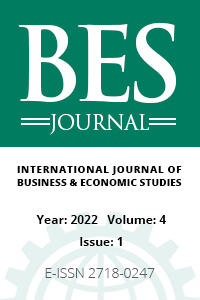Sosyal Sermayenin Müşterilerin Ilişki Memnuniyetine Etkisi
Bu araştırmanın amacı; sosyal sermayenin müşterilerin ilişki memnuniyetine olan etkisini ölçmektir. Ayrıca bilişsel, ilişkisel ve yapısal sosyal sermayenin müşterilerin ilişki memnuniyetine etkisini belirlemektir. Bu amaçlarla Düzce ilinde 364 mükellef üzerinde anket gerçekleştirilmiştir. SPSS analiz programı ile “Bağımsız Örneklem t-Testi”, “Tek Yönlü Varyans Analizi (ANOVA)”, “Pearson Korelasyon Analizi” ve "Regresyon Analizi yöntemlerinden yararlanılmıştır. Yapılan analizler sonucunda bilişsel, ilişkisel ve yapısal sosyal sermaye düzeyleri ile, yeniden müşteri olma niyeti ve ilişki memnuniyetleri arasında pozitif bir ilişki tespit edilmiştir. Ayrıca katılımcıların demografik ve mesleki özelliklerine göre sosyal sermeye düzeylerinin ve ilişki memnuniyet düzeylerinin farklılaştığı tespit edilmiştir.
Anahtar Kelimeler:
Sosyal Sermaye, İlişki Memnuniyeti, Serbest Muhasebeci Mali Müşavir
The Effect of Social Capital on Client’s Relationship Satisfaction
The purpose of the current study is to measure the effect of social capital on client’s relationship satisfaction. In addition, it aims to determine the effect of cognitive, relational and structural social capital on client’s relationship satisfaction. To this end, a survey was conducted on 364 clients in Düzce. In the SPSS analysis program, “Independent Sample t-Test”, “One Way Analysis of Variance (ANOVA)”, “Pearson Correlation Analysis” and “Regression Analysis” methods were used. As a result of the analysis, a positive correlation was determined between cognitive, relational and structural social capital levels, intention to become a client again and relationship satisfaction. In addition, it was determined that the social capital levels and relationship satisfaction levels of the participants varied depending on their demographic and professional characteristics.
___
- Aaker, D. A. (2004). Leveraging the corporate brand. California Management Review, 46(3), 6-18.
- Abdioğlu, H., & Yavuz, S. (2013). İşletmelerde sosyal sermayenin ölçümlenmesi ve raporlanmasina yönelik bir araştirma. Afyon Kocatepe Üniversitesi İktisadi ve İdari Bilimler Fakültesi Dergisi, 15(1), 25-56.
- Ağcasulu, H. (2017). Sosyal sermaye kavramı ve temel bakış açılarının karşılaştırılması. Süleyman Demirel Üniversitesi Vizyoner Dergisi, 8(17), 114-129.
- Allan, J., & Catts, R. (2014). Schools, social capital and space. Cambridge Journal of Education, 44(2), 217-228.
- Braun, S. (2002). Soziales Kapital, sozialer Zusammenhalt und soziale Ungleichheit. Aus Politik und Zeitgeschichte, B, 29(30), 2002.
- Çalişkan, Ş., Pehlivanoğlu, F., & Meçik, O. (2014). Bireysel kazançların belirlenmesinde sosyal sermayenin rolü (Yalova örneği). Cumhuriyet Üniversitesi İktisadi ve İdari Bilimler Dergisi, 15(1), 313-323.
- Cambra-Fierro, J., Melero-Polo, I., & Sese, J. (2015). Does the nature of the relationship really matter? An analysis of the roles of loyalty and involvement in service recovery processes. Service Business, 9, 297-320.
- Chirawattanakij, S., & Ractham, V. V. (2015). Knowledge adoption: The influential factors in the process. Business Information Review, 32(3), 158-167.
- Conway, K. D., & Fitzpatrick, J. M. (1999). The customer relationship revolution—a methodology for creating golden customers. In CRM Forum.
- DeWitt, T., & Brady, M. K. (2003). Rethinking service recovery strategies: the effect of rapport on consumer responses to service failure. Journal of Service Research, 6(2), 193-207.
- Erbil, C. (2008). Sosyal sermayeye örgütsel yaklaşım: bir model önerisi (Master's thesis, Selçuk Üniversitesi Sosyal Bilimler Enstitüsü).
- Grégoire, Y., & Fisher, R. J. (2006). The effects of relationship quality on customer retaliation. Marketing Letters, 17, 31-46.
- Jones, T., & Taylor, S. F. (2012). Service loyalty: accounting for social capital. Journal of Services Marketing, 26(1), 60-75.
- Karagül, M., & Masca, M. (2005). Sosyal sermaye üzerine bir inceleme. Ekonomik ve Sosyal Araştırmalar Dergisi, 37-52.
- Park, J., & Ha, S. (2016). Co-creation of service recovery: Utilitarian and hedonic value and post-recovery responses. Journal of Retailing and Consumer Services, 28, 310-316.
- Pizzutti dos Santos, C., & Basso, K. (2012). Do ongoing relationships buffer the effects of service recovery on customers' trust and loyalty?. International Journal of Bank Marketing, 30(3), 168-192.
- Putnam, R. D. (1995). Bowling alone: America’s declining social capital: originally published in journal of democracy 6 (1), Culture and Politics: A Reader, 223-234.
- Riaz, Z., & Khan, M. I. (2016). Impact of service failure severity and agreeableness on consumer switchover intention: Mediating role of consumer forgiveness. Asia Pacific Journal of Marketing and Logistics. 28 (3), 420-434.
- Şan, M. K., & Şimşek, R. (2011). Sosyal sermaye kavramının tarihsel-sosyolojik arkaplanı. Akademik İncelemeler Dergisi, 6(1), 88-110.
- Sharma Bhaskar, S., & N. Khera, S. (2014). Antecedents of discretionary risky-service behavior: an exploratory study. International Journal of Bank Marketing, 32(6), 477-493.
- Tsai, C. C., Yang, Y. K., & Cheng, Y. C. (2014). Does relationship matter?–Customers’ response to service failure. Managing service quality. 24 (2), 139-159.
- Tüysüz, N. (2011). Sosyal sermayenin ekonomik gelişme açısından önemi ve sosyal sermaye endeksinin hesaplanması:(uzmanlı tezi). TC Kalkınma Bakanlığı.
- Wan, L. C., Hui, M. K., & Wyer Jr, R. S. (2011). The role of relationship norms in responses to service failures. Journal of Consumer Research, 38(2), 260-277.
- Whiteley, P. F. (2000). Economic growth and social capital. Political studies, 48(3), 443-466.
- Yagil, D., & Luria, G. (2016). Customer forgiveness of unsatisfactory service: manifestations and antecedents. Service Business, 10, 557-579.
- Yüksel, K. (2015). İktisadi kalkınmada sosyal sermayenin rolü; Çorum iline yönelik bir analiz (Master's thesis, Hitit Üniversitesi Sosyal Bilimler Enstitüsü).
- ISSN: 2718-0247
- Yayın Aralığı: Yılda 2 Sayı
- Yayıncı: Mesut DOĞAN
